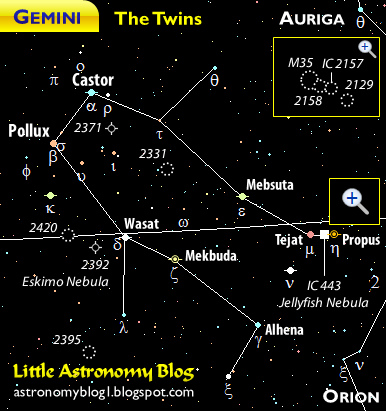Sunday, August 2, 2015
Gemini
Straddling the Ecliptic and part of the dense Milky Way band, GEMINI the Twins is a Zodiac constellation visible to Northern Hemisphere stargazers in the summer and spring seasons and in the southern summer for Southern Hemisphere stargazers. The twins of Gemini are Castor and Pollux in Greek and Roman mythology. Castor and Pollux are also the names of Gemini's brightest and second-brightest stars, respectively. Gemini is surrounded by the constellations of Auriga, Cancer, Canis Minor, Lynx, Monoceros, Orion, and Taurus. While some constellations contain a great assortment of galaxies, Gemini does not because its location among densely clustered Milky Way stars prevents us from seeing galaxies in telescopes. Gemini does have notable open star clusters and nebulae. Messier 35 (M35) and NGC 2158 are next to each other in the night sky. As shown in this NASA Astronomy Picture of the Day (link opens in new tab or window), NGC 2158 is a dense star cluster while M35 is comprised of mostly blue stars in a loose cluster. The Eskimo Nebula (NASA APOD image), also known as NGC 2392 and Caldwell 39, is one of the most famous planetary nebulae for its interesting resemblance of an Eskimo's face with a surrounding parka hood! Another interesting planetary nebula is NGC 2371, located between the stars Castor and Iota (ι) Geminorum. Finally, the Jellyfish Nebula (IC 443) near the star Propus (Eta (η) Gem.) is a supernova remnant straddling the night sky's dense Milky Way band.
Brightest Star: Pollux ("very sweet"), Beta Geminorum (β); 1.14 apparent magnitude
Second-Brightest Star: Castor ("he who excels"), Alpha Geminorum (α); 1.58 app. m.
Binary Stars and Multi-Star Systems: Castor (six stars), Mebsuta (Epsilon (ε) Gem. - binary), Mekbuda*, Propus*, and Wasat (Delta (δ) Gem. - three stars)
* Mekbuda (Zeta (ζ) Gem.) is a binary system with a variable star, while Propus (Eta Gem, η) is a triple-star system with a variable star.
Open Star Clusters: IC 2157; M35; and New General Catalogue (NGC) objects: 2129, 2158, 2331, 2395, and 2420
Nebulae: planetary NGC 2371, planetary Eskimo Nebula (NGC 2392), and Jellyfish Nebula (IC 443) supernova remnant
Subscribe to:
Post Comments (Atom)
Blog Background
The background has three Hubble Space Telescope images:
— LH 95 is a star-forming region in the Large Magellanic Cloud, Dorado constellation.
— Ant Nebula (also called Menzel 3) is an aptly-named planetary nebula located in the constellation Norma.
— Egg Nebula (also called CL 2688) is a protoplanetary nebula in the constellation Cygnus.
— LH 95 is a star-forming region in the Large Magellanic Cloud, Dorado constellation.
— Ant Nebula (also called Menzel 3) is an aptly-named planetary nebula located in the constellation Norma.
— Egg Nebula (also called CL 2688) is a protoplanetary nebula in the constellation Cygnus.



No comments - Post Comment Here
Post a Comment